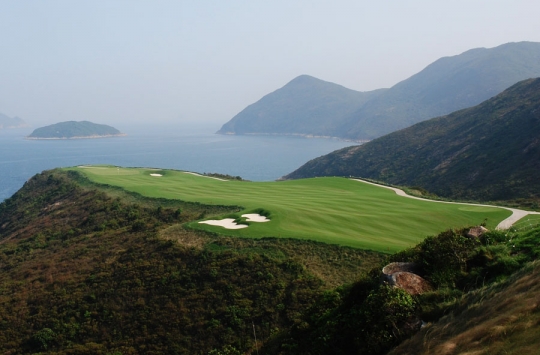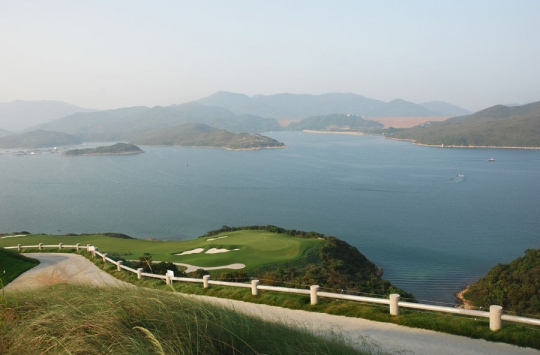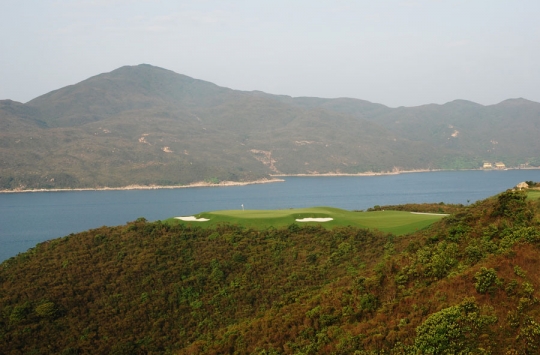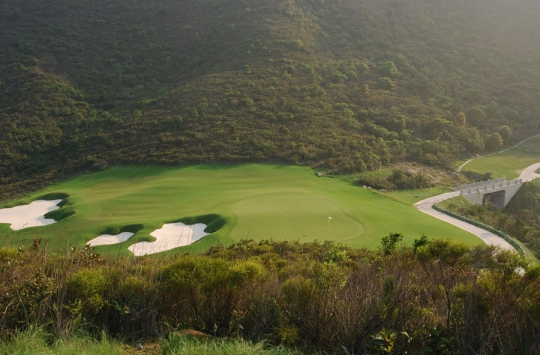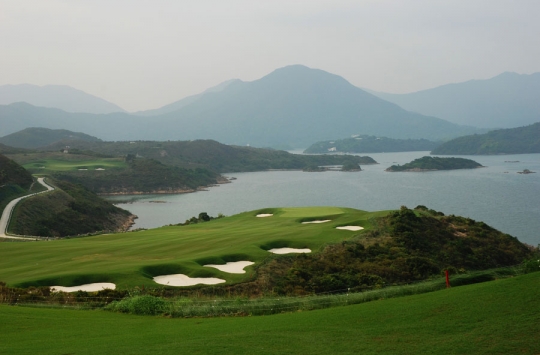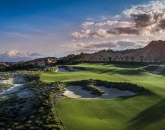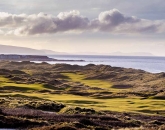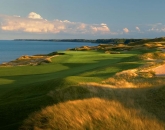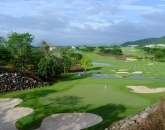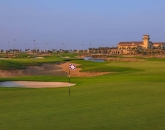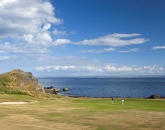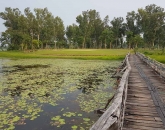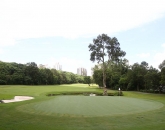Wow! Beautiful! Awesome! You’d think a group of sports journalists would be able to come up with a few better adjectives to sum up their experience of playing the recently unveiled East Course at Kau Sai Chau, but this wasn’t to be the case. There was one guy, a high handicapper from a publication that will remain nameless, who came in to the clubhouse bemoaning his score; but then again he had elected, for reasons known only to himself, to play from the blue tees. This was a definite error of judgment. This specially-arranged media outing did confirm one thing apart from the importance of selecting the right tee box however: that the Nelson & Haworth-designed layout, which cost a cool HK$300 million to come to life, is not only incredibly scenic, but it has helped raised the bar for all public golf facilities the world over. It is both beautiful and awesome. Wow!
But don’t take the media’s word for it. The course has been open for almost a month now, and opinion emanating from the locker room has proved overwhelmingly positive. The consensus being that this is a hugely fun track, one that rewards those willing to take the occasional risk, but one where bad shots will almost certainly get punished. In terms of difficulty, those I’ve spoken to—low handicappers and higher markers alike—rate it somewhere between the original Gary Player-designed South and North courses. It’s hard not to agree with what’s been said, but it should also be noted that this is also a very different test of golf.
For a start, there’s the elevation changes. While the North and South courses can be described as strongly undulating, the East is staggeringly so. Indeed, downright mountainous probably gives a better visual image. But when you consider the natural topography of this side of the island, the fact that they managed to squeeze in eighteen playable holes is already a commendable achievement. The fact that they managed to squeeze in eighteen highly memorable holes is a staggering feat of both design and engineering. The cart track—and this is most definitely a course that requires automotive power—comes in at a whopping 14 kilometers, which should give a clear indication of the kind of terrain we’re talking about here.
No less than nine holes feature dramatic altitude shifts and the course benefits strategically as a result. This is largely due to the width of the fairways. They might not always look it, but the landing areas, on the whole, are more than generous. Take the 4th, for instance. The back tee on this short par-4 sits high up in the clouds, a good two hundred feet above what appears to be just a sliver of fairway protruding out into the South China Sea. In actual fact, the mown grass measures nearly fifty yards wide, meaning club selection is far from restricted—you can have a crack with the driver, or you can play the percentages with a 4-iron. The thing about the East is that you always have options, which is always the sign of a well thought out golf course.
This visual deception is a recurring theme on the East: holes that look mightily intimidating from the tee, but are really far more manageable. With the exception of the par-3s, that is. The East’s strength, according to Brett Mogg of Nelson & Haworth, lead designer on the project, is its short holes—or as the case may be, its not so short, short holes. Played from the tips—which, sensibly, is only an option currently available to single figure handicappers—these could arguably be the strongest collection of par-3s in the region. With the exception of the 147-yard 15th, the one-shotters here are both long and fraught with danger. The fun starts at the 3rd, a mid-range hole that has trouble written all over it. A fiendishly grassy bank left of the green and total mayhem right makes this par-3 require the most precise of longish irons. Although, quite frankly, this is nothing compared to the 5th, a stunning, yet ferocious hole from the backs, where it measures in excess of 200-yards. The smart option here is to trundle your cart 70-yards forward to the white tees where a nice simple 9-iron shot over a vegetation-filled gorge awaits. The 8th is another brute, but I’ll reserve judgment on this one until the next time I play it. (If you play it from its full 232 yards and hit the green in regulation, write in and let us know—you might be the only one so far).
Any number of holes could have been designated the East’s signature hole, but this particular honour has been given to the 14th, another shortish par-4 that plays to a peninsula fairway that, once again, juts out into the ocean. It’s a very decent, not to mention dramatic, hole but it’s the views here that certainly earned it this tag. The Tanah Lot temple at the 14th at Nirwana Bali aside, there can’t be a more spectacular view in all of Asian golf. The scene, looking out towards the craggy outcrops to the south, is more reminiscent of the isles of the Andaman Sea than Hong Kong. To say it’s breathtaking is simply understating the matter.
People who don’t like blind shots—a charming feature for many—and fairly lengthy carries off the tee probably won’t get on with the East. While it is certainly more friendly than the North Course, this is no place for the rank amateur. The greens, many of which feature false fronts and run-off areas, not to mention ragged, minimalist-style bunkering, will more than likely make a fool of those lacking any short game prowess, but they are all undoubtedly fair. This seems to be the whole ethos of the East: play well, don’t be suckered into shots that you know, deep down, won’t come off; be brave on the shots that might and you’ll be rewarded, even in the notoriously fickle winds at Kau Sai Chau. But come out all drivers-a-blazing and you can forget it. Be smart, be sensible and, above all, savour what is undoubtedly one of the most fascinating courses to have opened in recent years.
New Course, New Grass
Unlike the North and South courses, the East hasn’t been laid out in Bermuda grass, the hardy strain of warm season grass that is used on the vast majority of courses across the region. Instead, the layout is covered entirely with Paspalum, a new-fangled variety that is becoming increasingly popular with new course projects the world over.
Paspalum evolved naturally on the coastal dunes of the eastern seaboard of the United States. Its genetically enhanced strains are famous within the golf industry for being saline tolerant, making it ideal for seaside courses and layouts that lack a quality water supply. The East uses Seashore (Salam) Paspalum on the tees, fairways and roughs, while Supreme Paspalum, a more delicate breed, is used on the greens.
“From a purely aesthetic point of view, Paspalum grass compares favourably to cool season grasses, because it retains its deep green colour throughout the year and stripes very nicely,” says Rick Hamilton, managing director of Asia Turf Solutions and a former superintendent at Kau Sai Chau. Striping, as its name implies, is the practice used by greenkeepers to add stripes to greens, fairways and tees, which give courses a fancy PGA Tour-type look about them.
“And because Paspalum has a broader leaf, the ball sits up very high on the fairways—you don’t get too many ‘skinny’ lies with it, which golfers like,” Hamilton continued.
But what of the greens? Because of Hong Kong’s notoriously extreme climate of high humidity, heavy rainfall and long periods of cloud cover, maintaining quality putting surfaces has never been easy—indeed, there’s a much-used phrase among greenkeepers the region over that goes something along the lines of: if you can grow grass in southern China, you can grow grass anywhere in the world.
“The big plus with Paspalum is that it handles the lack of sunlight very well, which makes it suitable for Hong Kong” said Hamilton. “Also, greens laid out with Paspalam don’t seem to suffer as much grain as Bermuda. Paspalum greens allow a very true and consistent roll, but it’s a little harder to get them up the speeds of, say, the Bermuda TifEagle grass. That’s not to say they can’t run fast; it just requires more work. A course laid out entirely with Paspalum is perfectly capable of holding a major professional event.”
Other local courses that use Paspalum include: SkyCity Nine Eagles (Salam fairways; Sea Isle 2000 greens), The Hong Kong Golf Club, Old Course (Salam fairways), Shek O Country Club (Salam fairways), Zhuhai Golden Gulf Golf Club (Salam fairways).
Click here to see the published article.


